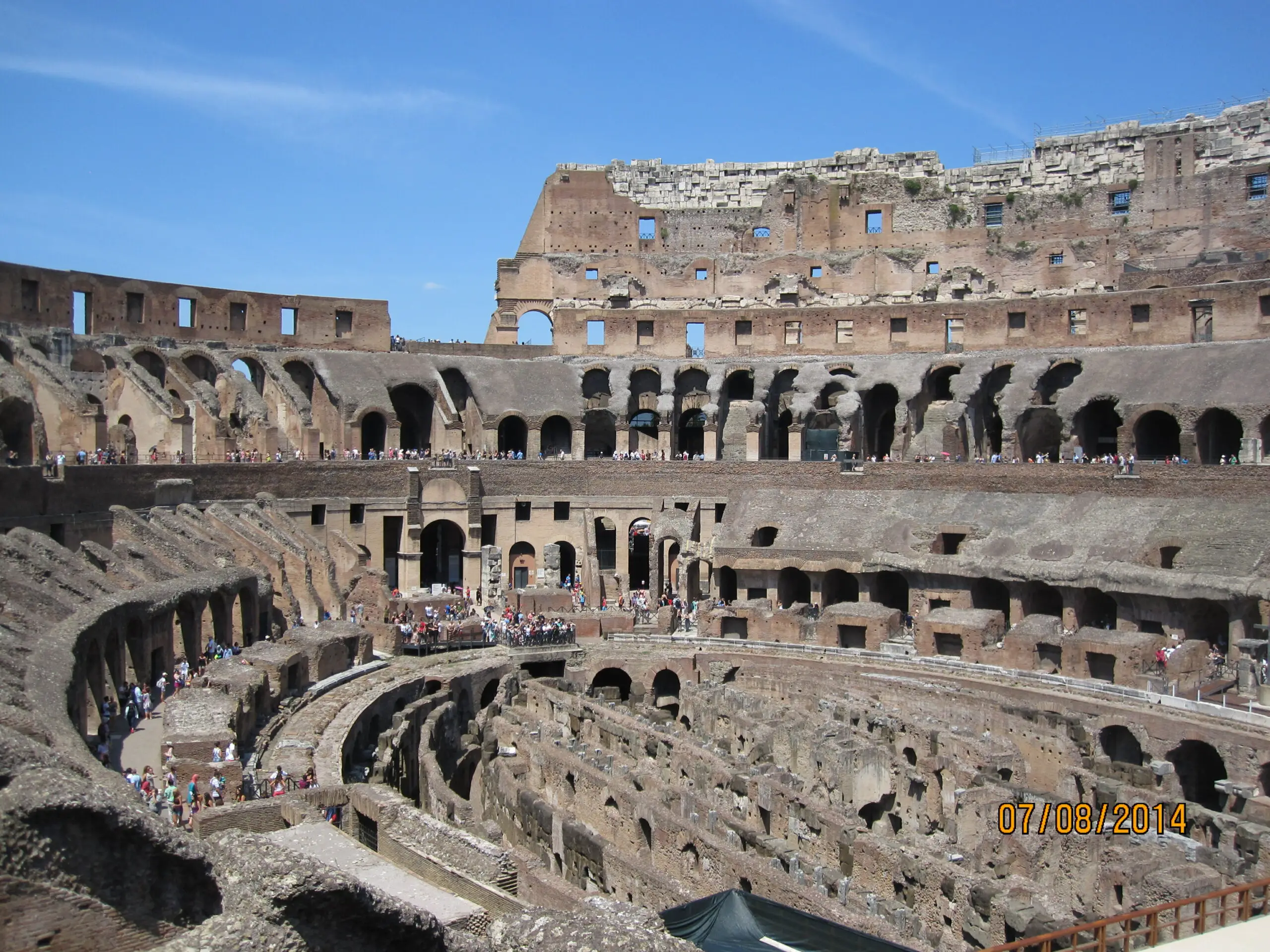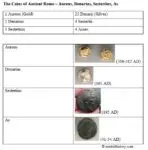Roman gladiators were probably some of the finest swordsmen that history has ever seen. But how did these men train for their deadly duels in the Colosseum? What was their secret to mastering their weapons?
The daily training of a gladiator consisted of repeating sword combinations against a vertical stake with wooden weapons that weighed double the amount of normal weapons. Experienced gladiators also trained with each other, sometimes using sharp weapons.
Let`s find out!
How did Gladiators train?
It is important to know that all Gladiators inside a gladiator school had a servile social status. Click here for more information on the different ways men could end up in a gladiator school and why some free men decided to leave their freedom behind to fight in the arena.
That means that the men who were training to become gladiators were the property of the owner of the gladiator school! The owner could train and punish these men like he saw it fit.
Disciplining men for the smallest wrongdoing by whipping or burning them with glowing irons was normal for maintaining discipline. That discipline was necessary since Gladiators were not only taught the different ways to handle their weapons but also how to die without showing emotions.
That last part, the dying without visible emotion, was one of the things Romans admired Gladiators for. More on why gladiators were expected to die without visible emotion or begging for their lives in my article here.
But let`s focus on how gladiators were trained to use their weapons:
New candidates arriving at the Gladiator school
The training process began the moment new candidates entered the gladiator school. After arrival, these men would be inspected by a physician (the gladiator schools were usually able to employ the best physicians, more on that here in my article.
Men who seemed too weak or for other reasons unlikely to finish training were sold to other owners. The really unlucky ones often made their way into the mines.
The men who were seen as fit to start training, the so-called novicii, would regularly undergo medical inspection during the course of their training. But first, every recruit would law down an oath in which he pledged his life to the owner of the gladiator school.
The gladiators’ oath consisted of him promising his owner to uncomplainingly accept any punishment and death by fire or sword.
Training begins
As soon as the recruits, now called tirones, were seen fit for training the owner of the school would turn them over into the hands of their trainers.
The gladiator trainers were usually former gladiators who were either too old or had been to badly injured to return to the arena themselves.
You can find more information on the career opportunities for retired gladiators in my article here.
Every one of the trainers, so-called doctores, was a member of a specific type of Gladiator!
Against popular belief, gladiators did have specific types with clearly set equipment and opponent. You can find more information about the different types of gladiators like the murmillo, the retiarius, or the Tharacian here in my article.
The trainers would closely watch every recruit and choose the men who were suitable for their type of gladiator.
For example, a trainer who had fought as a Murmillo, a heavily armored swordfighter would choose men with a good muscular predisposition.
Since a murmillo had to carry about 44 pounds the recruit had to be stronger than a retiarius who would only carry 13-18 pounds of equipment.
The recruits would then start training in the court of the gladiator school where long wooden stakes were standing upright.
Every recruit would stand in front of a stake and would then repeat a number of combinations with his sword.
The recruits would use wooden swords and shields that weighed about double as the normal shields and swords that were used during the fights.
Using heavier arms in training than in actual fights was the gladiators` way of progressively overloading the barbell in the gym. By the way, the roman soldiers trained exactly the same.
The daily training of a gladiator mainly consisted of repeating sword combinations against a vertical stake with wooden weapons that weighed double the amount as the normal weapons that were used during the gladiator games.
The goal of that repetitive training was to teach the recruits the ways of attacking an opponent without losing ones own protection. They were also trained in a way to use the gladius, their sword, for stabs, not blows.
More experienced gladiators would in addition to training at the stake also train with each other.
It is not entirely clear if they exclusively used sharp swords. But I tend to think that even seasoned gladiators regularly used the double-weighted wooden swords for muscle-building purposes.
All the training was done under the supervision of the trainers, brutal men who had no hesitations when it came to punishing even the smallest mistake!
The competition among a group of recruits was pronounced since there was a strict hierarchy inside every gladiator school.
Needless to say that being at the top of the hierarchy came with its advantages…
The hierarchy among roman Gladiators
Just like the roman army the gladiators also had a distinct sense of hierarchy. Actually, even the names for the different ranks inside a gladiator school are quite similar to those used in the roman army!
While the highest-ranking centurion in a roman legion was called primus pilus (=first spear) the best gladiator of every weapon type was called primus palus (=first stake). The Pilus is the stake that was used to train combinations of stabs and blows with the sword.
The rivalry was especially pronounced among the gladiators who had already fought in the arena, the so-called veteranii. Every veteranus tried to become primus palus himself.
The only way to become primus palus was to live longer than the current primus palus and additionally win every fight!
Since the best fighter of every gladiator type was called primus palus the second-best was called secundus palus (second stake).
Advantages that a primus palus had consisted of better accommodation (more on that later) and high social status among his comrades.
Ranks of roman Gladiators – chart
Please note that the chart only contains the ranks of active gladiators and recruits. The trainers, so-called doctores, are excluded.
| Primus palus | Best fighter of a gladiator type (for example a murmillo) |
| secundus palus | second best fighter of a gladiator type |
| veteranus | has already survived multiple fights in the arena |
| spectatus | has already survived his first fight in the arena |
| tiro | Recruit, is currently training for his first fight |
| novicius | Candidate for being accepted into the gladiator school |
It is important to emphasise that gladiators would fight against a man of similar rank, experience, and quality!
Do you want to learn more on why the tirones during their first fight had the highest mortality rate? You can find the answer here in my article.
Where did Gladiators live?
Gladiators lived inside gladiator schools, large gated properties with training facilities, own blacksmiths, a well-protected arsenal, a hospital, a kitchen, and barracks.
Two Gladiators would usually share a cell that measured 9ft on 13ft at most where they would sleep on the floor. The primus pilus sometimes had his own, more comfortable cell.
The gladiator spent most of his days behind the well-protected walls of the gladiator school where he would train, eat and sleep.
Most of the hundreds of gladiator schools in the roman empire were privately owned.
An exception were the four gladiator schools in Rome.
The four gladiator schools of Rome, the ludus magnus, the ludus dacicus, the ludus gallicus and the ludus matutinus were directed by public officials who had the trust of the roman emperor.
The reason for that was that the memory of the Spartacus rebellion was deeply burnt into the roman soul. Romans generally lived in constant fear of a slave rebellion and having thousands of well-trained gladiators inside Rome was seen as a critical security issue.
But because of the closeness to the Colosseum, more on it here, the gladiator schools could not be reopened outside of Rome. So giving the command over the gladiator schools to a trusted man was the next best option to outsourcing them.
By the way, the directors of the roman gladiator schools were lavishly rewarded for their service. Probably compensation for the risk that went along with living in a building full of professional killers…
The manager of the ludus magnus, the biggest gladiator school in Rome was rewarded with the sum of 200.000 sesterces per year.
Check out my article here for more information about the buying power a sesterce had!
What did Gladiators eat?
Gladiators ate their meals together in the refectory of their gladiator school
Roman gladiators would eat three similar meals (breakfast, lunch & dinner) per day, mostly consisting of barley and beans.
The diet of a gladiator mostly consisted of beans and barley. Because of the mass-consumption of barley gladiators were also called hordearii, meaning barley-eaters.
Check out my article here for more information on a gladiators diet.
Some of the physicians were not overly thrilled with that kind of diet. The famous Galen for example complained that the diet made the flesh of the gladiators soft. Meaning that he was complaining over the extra amount of bodyfat roman gladiators put on.
What was the physique of a Gladiator like?
What Galen didn`t mention is that a healthy amount of extra bodyfat was actually extremely beneficial for the survival of a gladiator.
The carb-heavy diet led to a physique that was totally different from the ripped physiques Hollywood likes to portray as gladiators.
But that is a story for another time. Click here for my article if you want to find out more about the physiques of the gladiators and what benefits a higher bodyfat percentage had.
Take care of yourself because you deserve it. You really do.
Until next time
Yours truly
Luke Reitzer
Sources
K. Nossov; Gladiator: The complete Guide to Ancient Rome`s Bloody fighters (2011).
F. Meijer; Gladiatoren. Das Spiel um Leben und Tod (Amsterdam 2003).
M. Junkelmann, Das Spiel mit dem Tod. So kämpften Roms Gladiatoren (Mainz am Rhein 2000).

